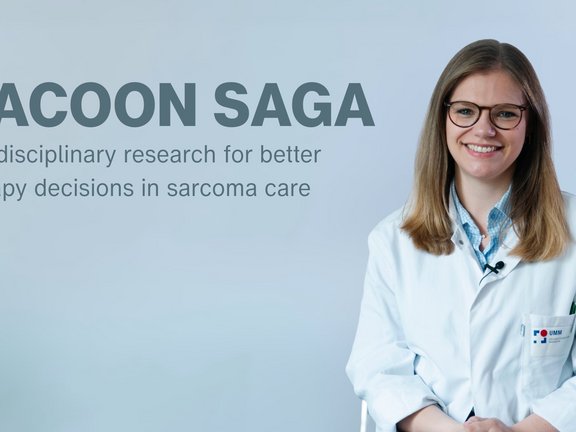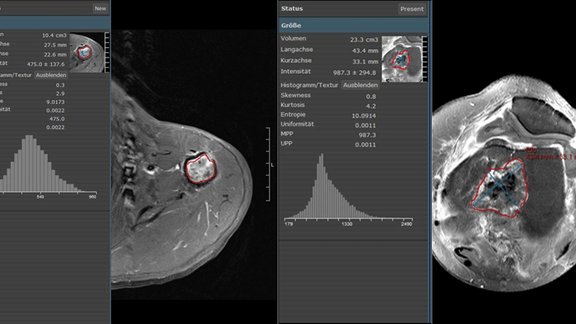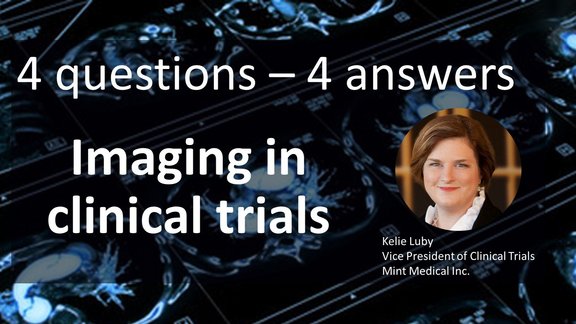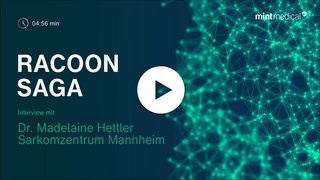
RACOON SAGA: Interdisciplinary Research for Better Therapy Decisions in Sarcoma Treatment
This is exactly where the RACOON-SAGA project comes in, conducted within the framework of the Network University Medicine (NUM). The project aims to improve the pretreatment characterization of soft tissue sarcomas through imaging and clinical data.
We spoke with Dr. Madelaine Hettler, physician at the Sarcoma Center of Mannheim University Medical Center. Together with Prof. Dr. Jens Jakob, she leads the RACOON-SAGA project within the Network University Medicine (NUM).
What is RACOON SAGA?
SAGA stands for Cooporation of Clinical and Radiology Sarcoma Experts at RACOON Sites to Improve the Pretreatment Assessment, Grading, and Multimodal Treatment Allocation in Patients with Rare Cancers.
In short, the project aims to improve the pretreatment characterization of soft tissue sarcomas. Since therapy decisions for sarcomas are always made in an interdisciplinary setting,
RACOON SAGA was also designed as an interdisciplinary project. Surgeons and radiologists work closely together to optimize the diagnostic pathway.
The project aims to investigate how functional MRI data—specifically the Apparent Diffusion Coefficient (ADC) derived from diffusion-weighted MRI imaging—correlate with tumor grading. Early studies have already shown promising results. One of these studies was conducted by our team and now serves as the foundation for a larger-scale analysis to obtain statistically robust findings.
What exactly are sarcomas?
Sarcomas are rare tumors. At the Sarcoma Center in Mannheim, the focus lies primarily on soft tissue sarcomas, which can occur at any age and in virtually any part of the body. Most commonly, they appear in the extremities, with incidence peaks in later adult life.
Treatment options for sarcomas include surgery, radiotherapy, and chemotherapy. Which modality is used and in what sequence depends heavily on pretreatment characterization and tumor grading.
Why is this project important for medical research?
Currently, the gold standard for characterizing sarcomas is a biopsy, which is histopathologically analyzed to establish grading. This grading is a key basis for therapy decisions. The challenge is that sarcomas are often large and highly heterogeneous, so a biopsy may not always be representative of the entire tumor.
The aim of the SAGA project is to improve tumor grading and assessment prior to therapy decisions by incorporating radiological information.
How is the SAGA study designed?
We conduct RACOON SAGA using a structured template. This means we collect MRI images, annotate them with various parameters, and at the same time gather clinical and prognostic patient data. These include tumor and patient characteristics, treatment details, and prognostic outcomes such as the development of metastases or mortality.
What challenges need to be addressed?
The biggest challenge in projects involving soft tissue sarcomas is their rarity. Only a limited number of cases are available, and not every patient receives the functional MRI imaging needed for this study. The great advantage of RACOON and the NUM network is the ability to pool images and cases from across Germany. This makes it possible to collect a sufficient number of cases to generate statistically robust results.
What is the ultimate goal of RACOON SAGA?
The overarching goal is to improve the pretreatment characterization of soft tissue sarcomas to enable more tailored therapy decisions for patients. One of the main challenges is so-called undergrading: small biopsies do not always capture the full heterogeneity of the tumor. Radiology offers a clear advantage here, as it allows comprehensive imaging of the entire tumor.
We welcome all sites that wish to participate in this project, as the more imaging and clinical data we collect, the more meaningful our analyses will become.
The conversation with Dr. Hettler highlights the importance of interdisciplinary collaboration and structured data collection in sarcoma research. With projects like RACOON SAGA, imaging and clinical data can be more closely integrated to improve diagnostics and therapy decisions for rare tumors.
We sincerely thank Dr. Hettler for sharing her insights and wish the project continued success.
Dr. med. Madelaine Hettler is a resident physician in the Department of Surgery at Mannheim University Medical Center and co-coordinates the RACOON SAGA project with Prof. Dr. Jens Jakob. For her scientific work, she was awarded the 2024 Research Prize of the German Sarcoma Foundation. For questions regarding RACOON SAGA, you can contact the team at sarkomchirurgie@umm.de.
Related Resources
Related Resources

University Hospital Ulm: Pilot study shows discriminatory power of MRI-based 3d texture analysis for bone lesions
Distinguishing between enchondroma, a benign tumor, and low-grade chondrosarcoma, which is a low-aggressivity malignancy, is a frequent challenge, as…

4 Questions – 4 Answers // Imaging in Clinical Trials
Mint Medical, Inc. Vice President of Clinical Trials, Kelie Luby Discusses Advances in Imaging Analysis in Clinical Trials and What’s Next for Mint…

Joint partnership between Mint Medical and Siemens Healthineers syngo.via
Siemens Healthineers and Mint Medical joined forces to accelerate imaging and result reporting software availability in hospitals when and where it is…
